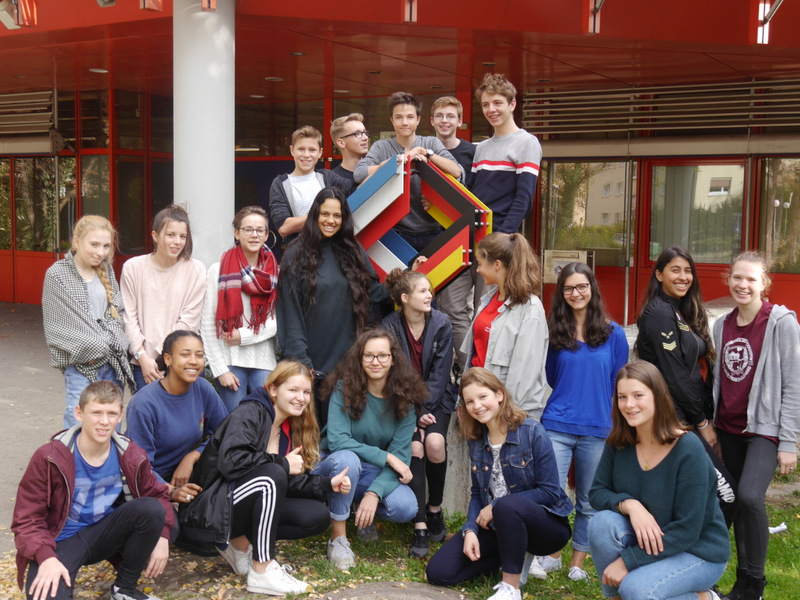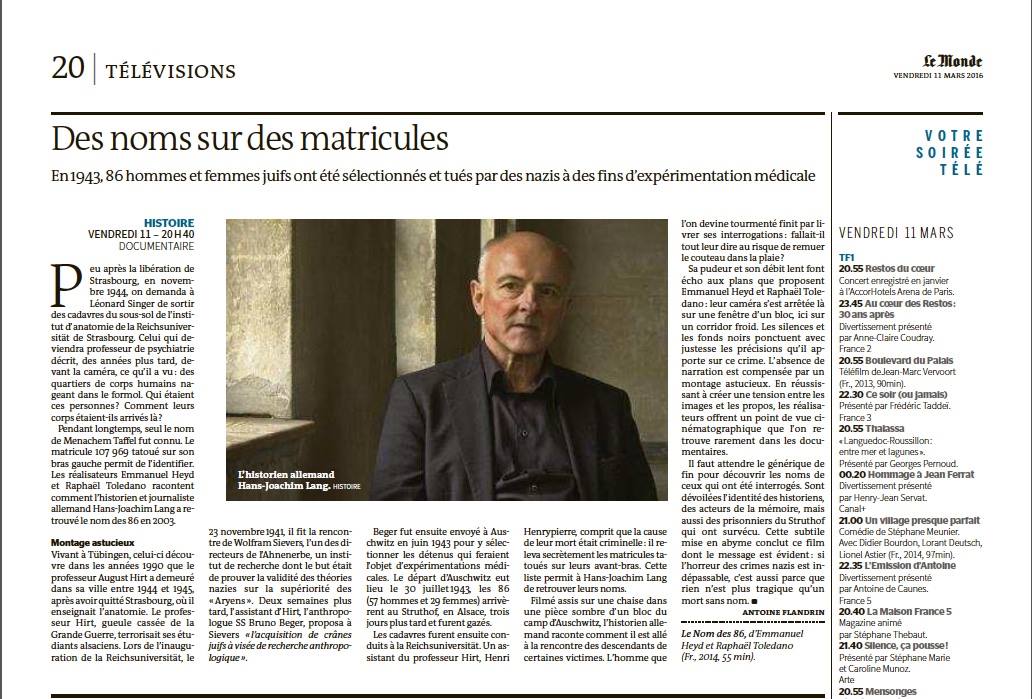Chronicle - News
The information on this site go beyond that contained in my book "The Names of the Numbers", published in 2004 (german paperback 2007). This website will be continually updated with information about what has taken place since the book's publishing, and what additional details I have researched since then. The most recent information can be found right at the beginning. At the very end, I have included information about the incentives for and the research leading up to this project.
2024
Spring
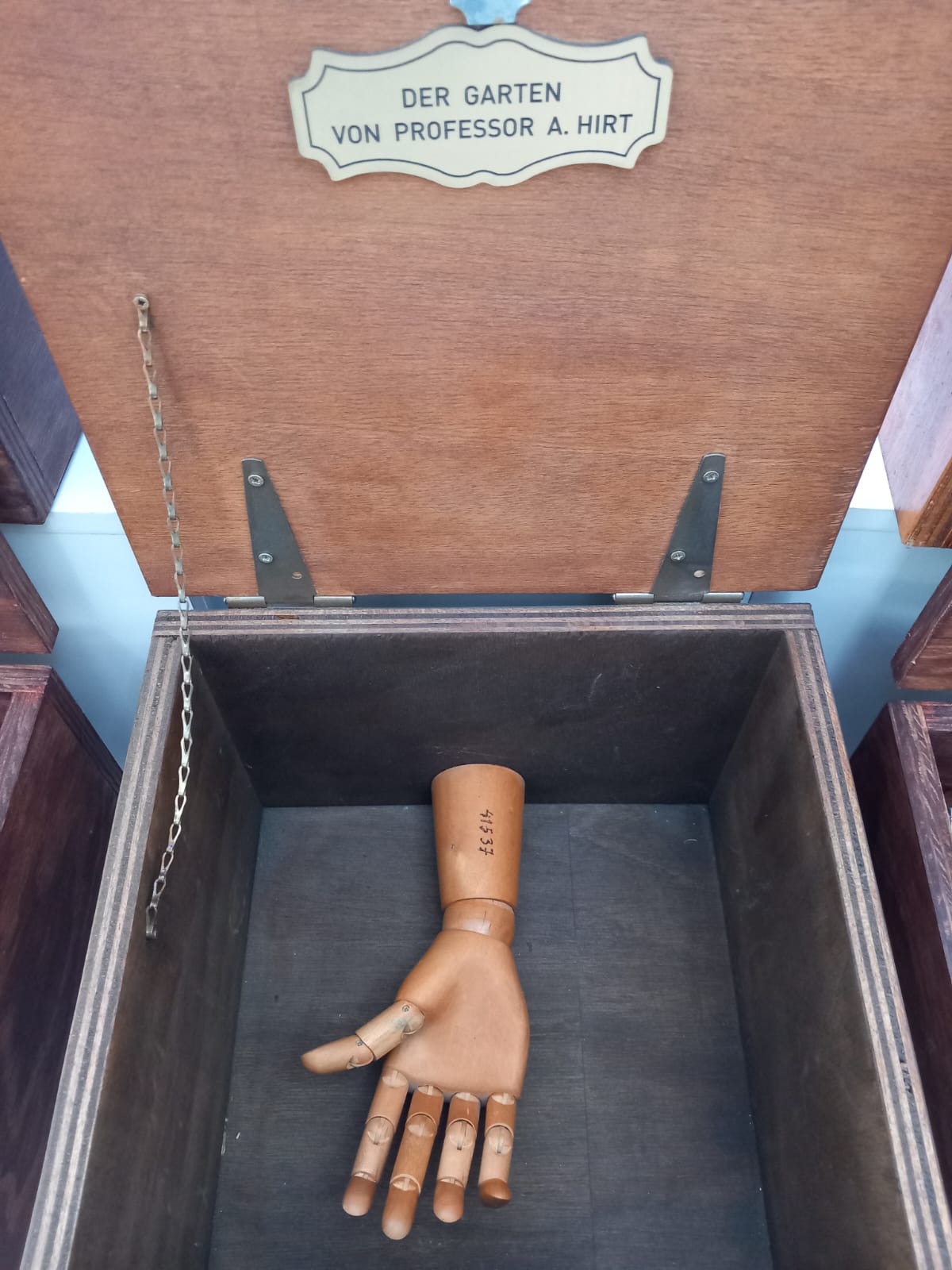
"The greatest and most precious heritage of humanity is memory. It is an ethical investment in time". So writes Greek artist Xenis Sachinis in an introduction to his exhibition "Memory and Nemesis" at the Jewish Museum of Thessaloniki. He presents various Holocaust crimes in the form of wooden memorial shrines. In one of these shrines, he uses the example of one of the 86 Jews murdered to illustrate Hirt's crime. The number 41547 refers to the concentration camp number tattooed on the left forearm of Nety Aruch, a Greek woman from Thessaloniki, in Auschwitz.
Photo: Mutschler
January 28th
Lecture at the Neckarelz memorial site, a former satellite camp of the Natzweiler-Struthof concentration camp.
2023
12-15 June
After separate intensive preparations by French students at the University of Strasbourg and German students at the University of Tübingen (lecturers Christian Bonah, Reinhard Johler, Hans-Joachim Lang, Jeanne Teboule) on the politics of memory, the two groups met in Strasbourg for an exchange. They were joined by 15 family members of the 86 who had travelled from the USA, Israel, France and Switzerland. The programme included visits to the Struthof-Natzweiler camp, including the new permanent exhibition in the gas chamber building, the Anatomical Institute, the Jewish cemetery and the European Parliament building.
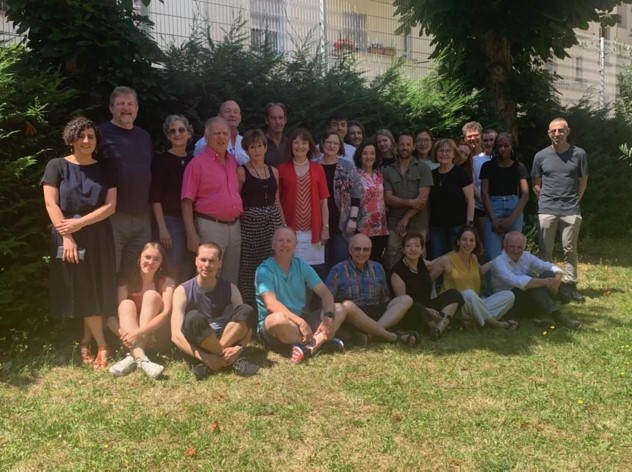 Final picture of the meeting between students from Tübingen and Strasbourg and members of the 86.
Final picture of the meeting between students from Tübingen and Strasbourg and members of the 86.
June 17th
Three granddaughters and two grandsons of Alice Simon make a detour to Tübingen before returning to the USA. In a packed hall at the district office, they are interviewed by Wolfgang Sannwald and several youth leaders about how they and their families found out about the crime against the 86 and how they are dealing with it.
August 30th
Stumbling stones are laid in Berlin for two of the 86 people murdered. They were organised by the "Prenzlauer Berg" Stumbling Stone Initiative. Harri Bober (and five other members of his family) at Choriner Straße 26 and Emil Sondheim at Varnhagenstraße 13 will be honoured.
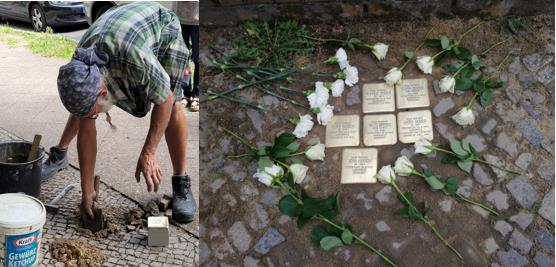 Stumbling Stones laid in Berlin: Varnhagenstraße 13 (left) and Chorinerstraße 26.
Stumbling Stones laid in Berlin: Varnhagenstraße 13 (left) and Chorinerstraße 26.
Lectures in Berlin (Charité), Hannover (Medizinische Hochschule), Tübingen (Anatomisches Institut), Karlsruhe (Pädagogische Hochschule), Eschwege (ehemalige Synagoge), Gießen (Institut für Medizinethik).
2022
End of May
The German School of Thessaloniki publishes a book entitled "The Names of Numbers. History in translation - Τα ονόματα των αριθμών. Μεταφράσoντας την ιστορία" is a remarkable book in German and Greek. It contains the 86 biographies on this website, written by the pupils of these students in Modern Greek classes and in a translation group (the supervising teachers): Maria Anthopoulou, Maria Kotidou and Christina Preftisi). Michael Stier also taught the historical background to the crime in his History class. Lefteris Raftis, an art teacher at the German School, designed the 150 pages in an appealing way. 46 of the 86 Jewish men and women were from Thessaloniki.
May 2nd
After nearly six years of work, the internationally composed and independently researched Commission historique has presented its Final report on the Faculty of Medicine of the Reichsuniversität Strasbourg 1941-1944 and officially handed it over to the President of the University of Strasbourg, Michel Deneken. The Commission was chaired by Florian Schmaltz (Berlin) and Paul Weindling (Oxford).
The report is available online (in French): https://applications.unistra.fr/unistra/visionneuse/rapport-commission-historique-Reichsuniversitat-Strassburg/2/
2018
December 4th
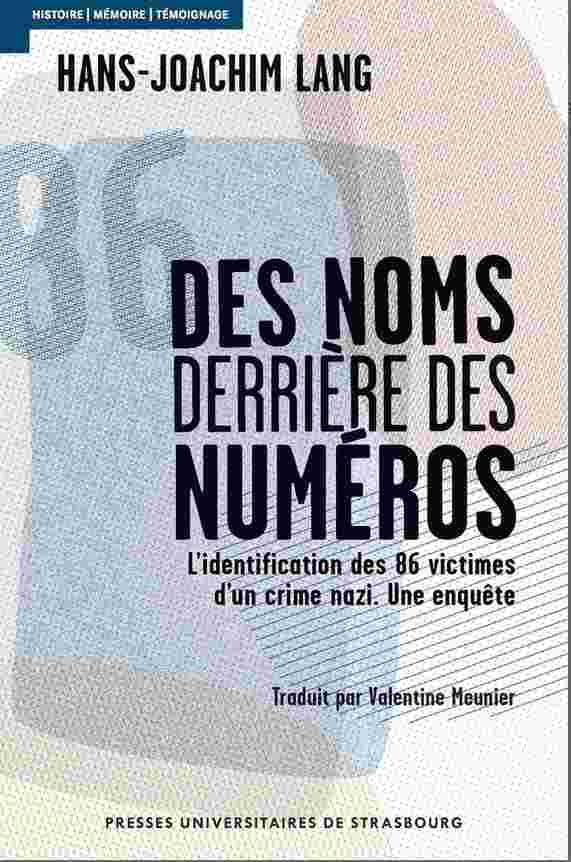
"Die Namen der Nummern" is published as an expanded new edition in French. Title: "Des noms derrière des numéros. L'identification des 86 victimes d'un crime nazi. Une enquête." Johann Chapoutot, professor at the Université Paris-Sorbonne, has written a foreword and Georges Yoram Federman, a psychiatrist from Strasbourg, an afterword. The translation was done by Valentine Meunier. The volume is published by Presses Universitaires De Strasbourg
October 11th
Lecture to first year students at the Medical University of Hannover..
May 4th
Visit to the German School in Thessaloniki. Lecture to the pupils in the presence of the German Consul General, who gave a welcoming address.
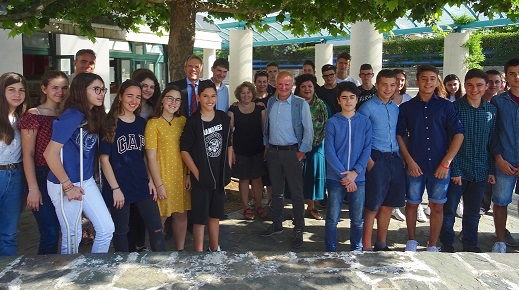
Pupils from the German School in Thessaloniki.Photo:
April 15th
After the Easter holidays, German schools in The Hague, Oslo, Thessaloniki and Warsaw began translating the biographies of the 86 victims of the "Ahnenerbe" crime described on this website into Dutch, Norwegian, Greek and Polish. They are following the example of teachers Magali and Frank Hack from Freiburg, who started the translation project in French with a group of pupils from the Franco-German Gymnasium in Freiburg and were awarded the Prix Corrin in Paris for their work.
March 14th
Lecture in Lüneburg at the invitation of the gynaecologists in the Lüneburg district as part of an advanced training event.
February 28th
Lecture in Oświęcim at the invitation of the Auschwitz-Birkenau Museum as part of a training course for guides at the memorial site.
January 26th
Lecture at the Ernst Abbe Library Jena at the invitation of the city of Jena and the Lesezeichen association
.
January 25th
The Prix Corrin was awarded in Paris to the pupils of the Franco-German Gymnasium in Freiburg for their translation project. Under the guidance of their teachers Magali and Frank Hack, they translated the 86 biographies on this website into French. Congratulations and many thanks!
See also:
2017
November 21st
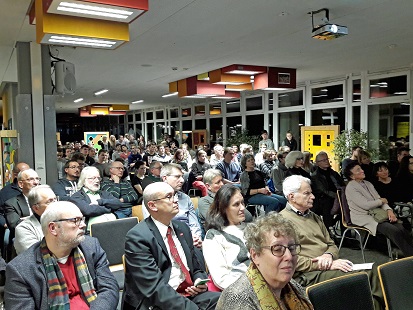 For the first time in over 47 years, I returned to Friedrich-Magnus-Schwerd-Gymnasium Speyer, my former school. As a guest of the "Lectures on Science and Current Affairs" series, I spoke in the foyer on the topic of "Murders for a Skeleton Collection. A Nazi scientific crime and its victims". (Bild: FMGS)
For the first time in over 47 years, I returned to Friedrich-Magnus-Schwerd-Gymnasium Speyer, my former school. As a guest of the "Lectures on Science and Current Affairs" series, I spoke in the foyer on the topic of "Murders for a Skeleton Collection. A Nazi scientific crime and its victims". (Bild: FMGS)
November 20th
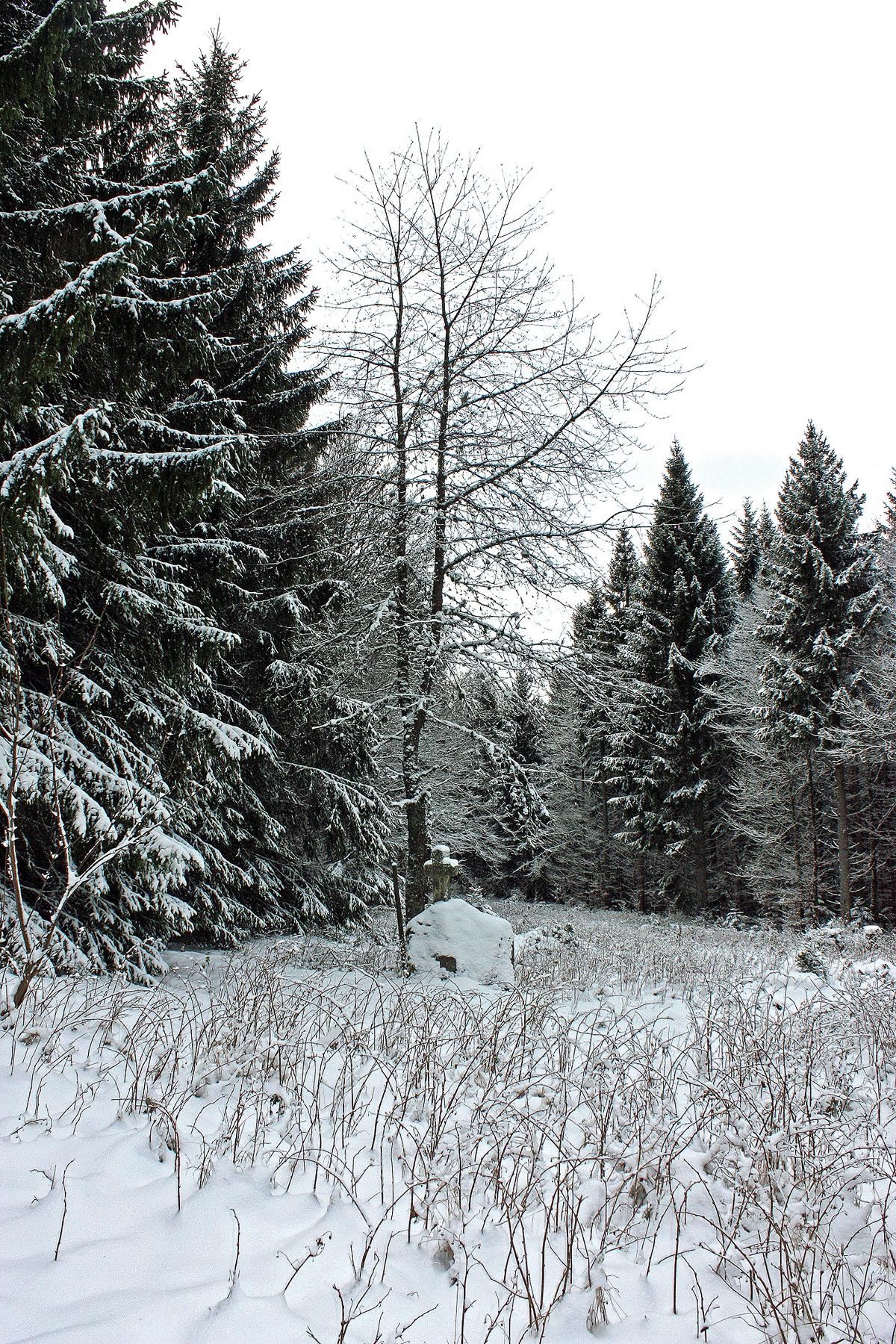
Lecture to four classes of tenth graders at the Bildungszentrum Bonndorf in the southern Black Forest. The event was organised by history teacher Klaus Morath. After lessons in the afternoon, he and Leon Stoll, a former pupil of the school, showed me the places where August Hirt had last spent time. The professor of anatomy had fled from Tübingen to the Black Forest in mid-April 1945 and found shelter in a forest hut ("Tiroler Hütte") near the Schluchsee. This hut no longer exists. From there, he walked every morning to an evacuee farm in the forest to listen to the news on the radio. On 2 June 1945, Hirt shot himself in the heart. He did so in the immediate vicinity of the "Steinerne Krizle" above the lake (right, photo: Lang). Hirt was buried in the town cemetery of Grafenhausen.
October 12th
Lecture to first year students at the Medical University of Hannover..
October 11th
Invitation from the Bezirksverband Pfalz to a lecture in Strasbourg about the 86 victims of the "Ahnenerbe". The lecture is part of a week-long youth commemoration trip organised by young people from the Palatinate. As a special feature, it is a joint event with pupils from the Ecole Européenne de Strasbourg in its auditorium. In the afternoon, a joint visit to the grave of the 86 at the Jewish cemetery in Strasbourg-Cronenbourg.
May 17th
Lecture at the - take a deep breath - Rabb Institute for Holocaust Studies at the Department of Sociology and Anthropology of the Ben Gurion University of the Negev (Israel). Recently, this institute has been cooperating with the Ludwig Uhland Institute for Empirical Cultural Studies at the Eberhard Karls University of Tübingen. The lecture began with a review of the life of Frank Sachnowitz, one of the 86 Jews murdered in the Struthof Natzweiler concentration camp. I was delighted that Frank Sachnowitz's nephew, Jechiel Porat, who lives in Israel, travelled here especially for this lecture.
May 11th
For my books " Die Namen der Nummern" and "Die Frauen von Block 10. Medizinische Experimente in Auschwitz" I have been awarded the Research Prize "Champions Award 2017" by the Centre for Medicine after the Holocaust (CMATH). The external framework is the Second International Scholars Workshop "Medicine in the Holocaust and Beyond". 140 scholars from 17 countries are taking part in the four-day conference, which is being held at Western Gallilee College.
April 27th
A lecture at the Deutsch-Französisches Gymnasium in Freiburg marks the beginning of a dedicated translation project. The pupils are translating biographical texts from this website about the 86 victims of the "Ahnenerbe" crime into French. They are being guided by their teachers Magali and Frank Hack.
Klasse 2nde ES (10. Klasse, Wirtschaftszweig) at the Deutsch-Französisches Gymnasium in Freiburg. Photo: Hack
2016
March 11th
The French daily newspaper "Le Monde" refers to the film "Le nom des 86" and discusses the research on which it is based.
March
The Czech translation of "Die Namen der Nummern. Wie es gelang die 86 Opfer eines NS-Verbrechens zu identifizieren" has been published under the title "Jména čísel - Jak se podařilo identifikovat 86 obětí jednoho nacistického zločinu"
February 24th
After long planning, intensive preparations, with professional graphic design by Christiane Hemmerich (Tübingen) and thanks to financial support from the Hamburg Reemtsma Foundation, the first "construction phase" of this websitegoes online.
Lecture in Tübingen (Leibniz-Kolleg).
2015
September 6th.
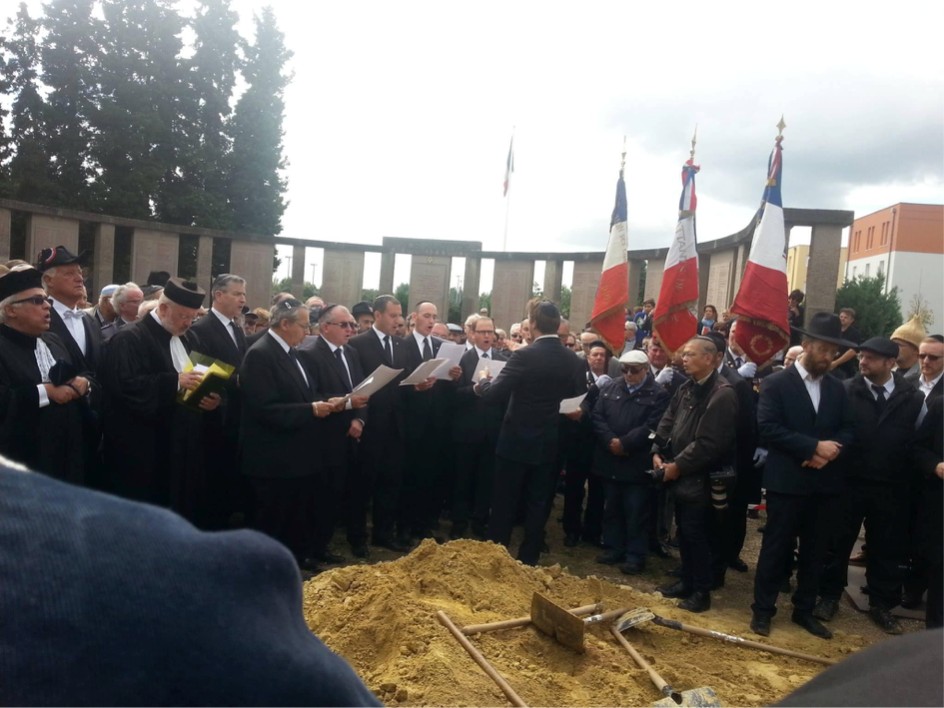
Jewish Cemetery in Strasbourg Photo: Lang
The forensic samples found in the Institute for Forensic Medicine of the Strasbourg University, attributed to Menachem Taffel, were - without thereby ending the lively discussions of the past weeks - interred in the Jewish cemetery in Strasbourg after a funeral service in the late morning. Several hundred people took part, including the mayor of Strasbourg and the president of the university.
July 9th.
Raphael Toledano examines historical forensic samples in a closed-off room of the Institute together with the director of the Institute for Forensic Medicine (Institute de Médecine Légale) at the University of Strasbourg, Professor Jean-Sébastien Raul, and makes a discovery that makes news across the world. It has to do with three small glass containers, in which tiny bits of leftovers from a human stomach and five small pieces of skin were preserved, which can be attributed to Menachem Taffel, one of the 86 “Ahnenerbe” victims. These samples come from the autopsies, taken by French forensic scientists after the discovery of the corpses. One of them, the professor Camille Simonin, had kept these samples in his institute and offered them in 1952 in a French military court as evidence. After that, they seemed to have been forgotten, until Toledano discovered the writings of Simonin in a French archive. Rauls Vorgänger had denied the inspection, which now led to the sensational discovery. Toledano said, with consternation, “What Simonin preserved of Hirt’s victims has landed exactly where Hirt in his racial mania wanted them to be: in a museum.”
May 21st.
Debbie Konkol, Joanne Weinberg and Chris Halverson visit the grave of their grandmother with their husbands. On the grave stone they place stones, brought from the USA: three stones in their own name, two more for their sibling Betsy and John Simon, as well as for both other grandchildren of Alice Simon, namely Peter Andersen and Kris Andersen.
May 20th.
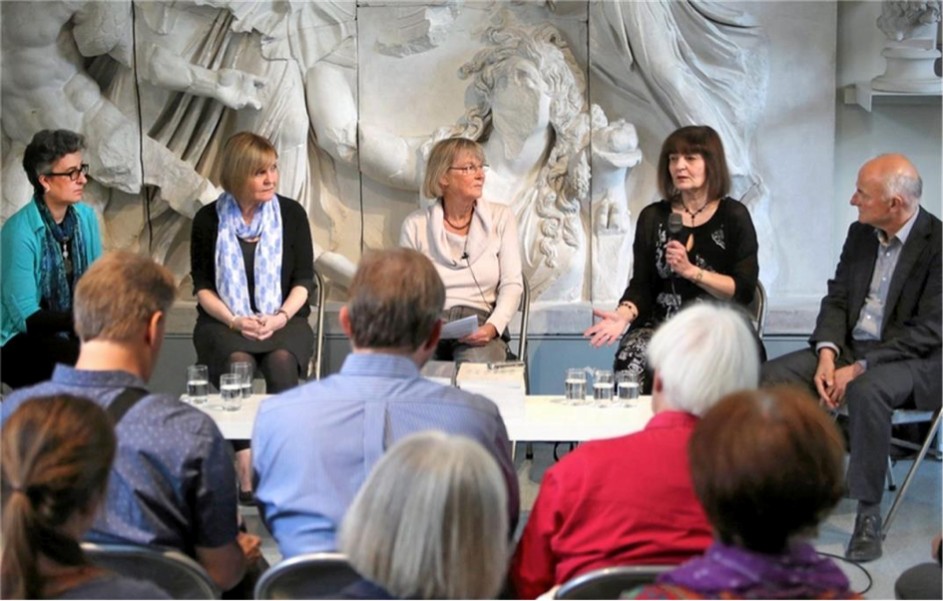
Discussion hour in the Rittersaal in the Castle Hohentübingen in Tübingen
“Remembering the Holocaust” is a conversation hour in the knights’ hall of the Schloss Hohentübingen, moderated by the journalist Ulrike Pfeil (Middle). Three granddaughters of Alice Simon (one of the 86 “Ahnenerbe” murder victims), who came from the USA, speak with Hans-Joachim Lang (right) about how present the experience of the Holocaust continues to be in their family today. The granddaughters are Chris Halverson (left), Joanne Weinberg (second from left) and Debbie Konkol (second from right).
April 29th.
Cinema Museum in Tübingen, the first German showing of the documentary film “Le nom des 86” with German subtitles, in the presence of both filmmakers.
April 27th.
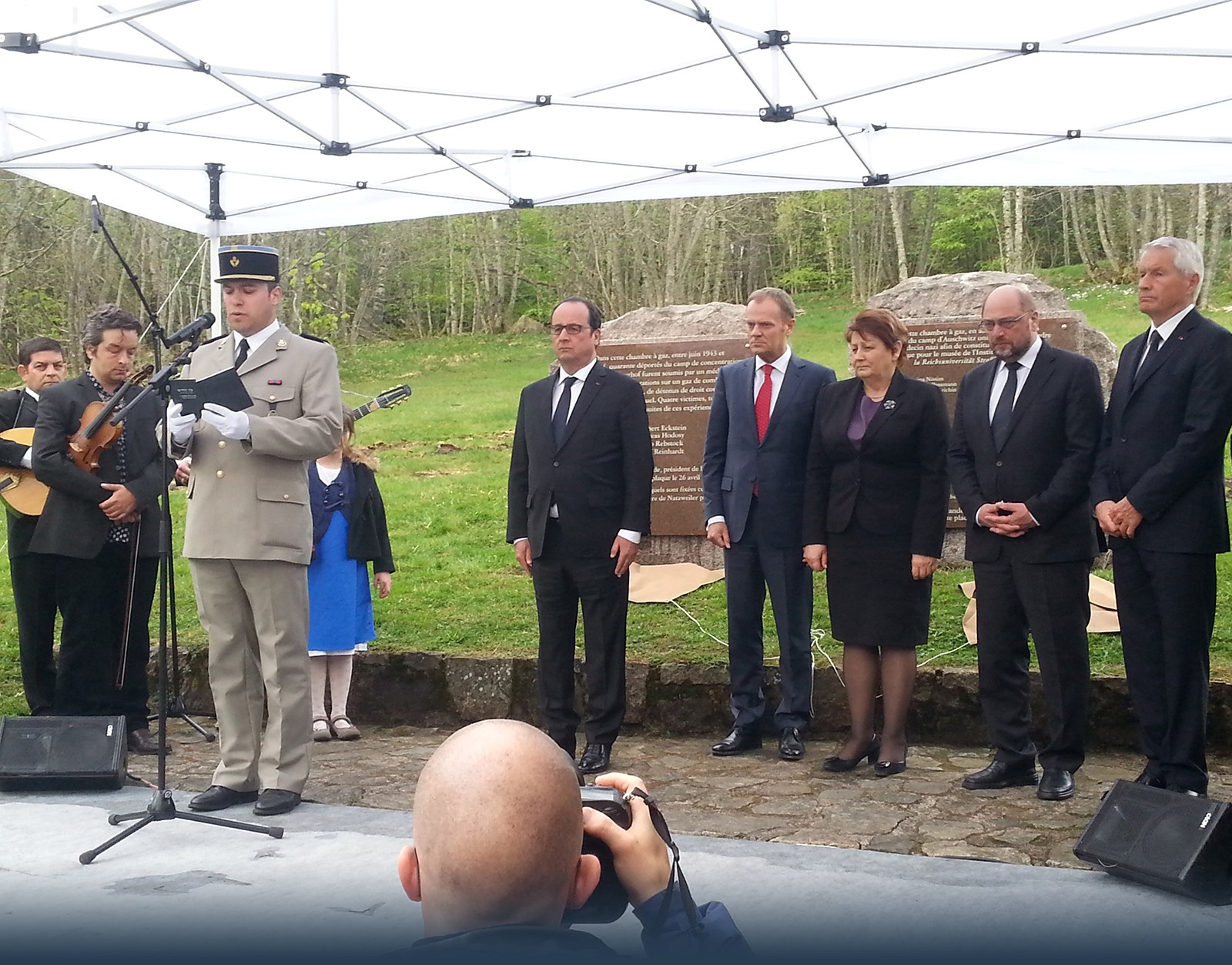
The revelation of the memorial stone next to the gas chamber of the concentration camp Natzweiler-Struthof, Photo: Lang
On the terrain of the former concentration camp Natzweiler-Struthof, the French president Francoise Hollande (middle) commemorated the NS victims with leading European politicians. Prior to this they revealed two memorial stones next to the former gas chamber. The one to the right gives the names of the 86 murdered Jewish men and women. Also present at the ceremony were (to the right of Hollande): European Council President Donald Tusk, the Latvian Prime Minister Laimdota Straujuma (their country has the EU Council presidency at this time), the President of the European Parliament, Martin Schulz, and the General Secretary of the Council of Europe, Thorbjørn Jagland.
April 23rd.
Opening of the exposition “In Fleischhacker’s Hands” in the castle Hohentübingen (until June 28th). Hans Fleischhacker was one of the two anthropologists, who selected Jews from amongst the prisoners in Auschwitz in June 1943 for a skeleton collection, which was to be put on display at the Reich University in Strasbourg. Fleischhacker had given his trial lecture on June 8th at the Medicine Department of the University of Tübingen, thereby successfully concluding his Habilitation exams. The very next day, he traveled to Auschwitz.
Theme: Fleischhacker’s (un)forgotten victims. In: Jens Kolata et al. (ed.): In Fleischhacker’s Hands. Science, Politics and the 20th Century. Exhibition catalog. Tübingen 2015, P. 185-199.
Lectures in Berlin (Island Gallery), Konstanz (College of Further Education), Wangen/Höri (Freundeskreis Jacob Picard), Tübingen (University: extracurricular studies; International Program; Carlo-Schmid-Gymnasium) .
2014
December 1st.
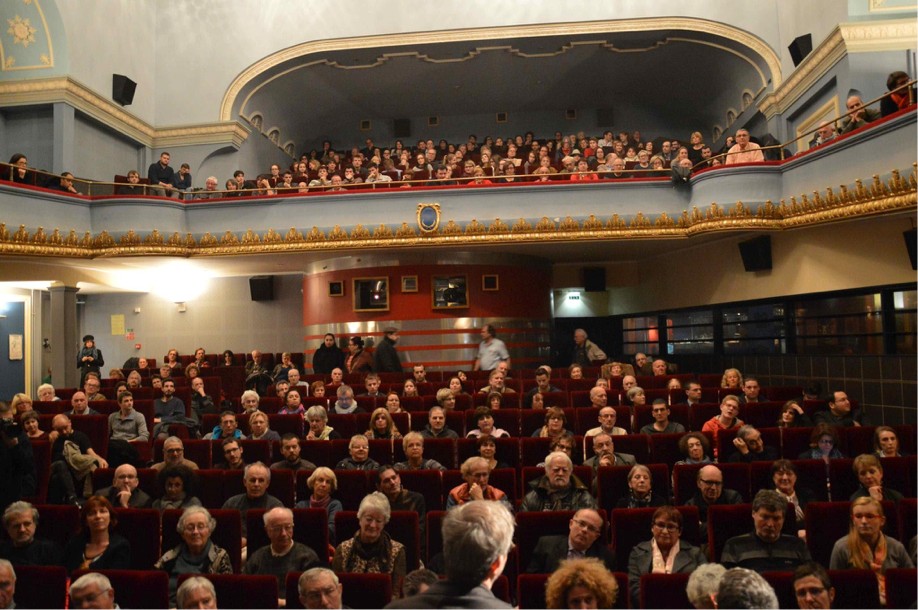
Cinéma L’Odysée on December 1st, 2014, Photo: Truong-Ngoc
Cinéma L'Odyssée in Strasbourg, Premier of the film documentary „Le nom des 86“ of the two French filmmakers Dr. Raphael Toledano and Emmanuel Heyd.
Lectures in Flensburg (College of Further Education), Göppingen (Jewish Museum), Dudenhofen/Pfalz (Community Center), Prague (Heinrich Böll Foundation), Thessaloniki (Goethe Institute), Ofterdingen (Library), Tübingen (University: International Programs), Tailfingen (Concentration Camp Memorial).
2013
Theme in the “Annals of Anatomy,” 195 (2013) 373-380. Title: August Hirt and “extraordinary opportunities for cadaver delivery” to anatomical institutes in National Socialism: A murderous change in paradigm.
Lectures in Groß Gerau (College of Further Education + Work and Life), Cologne (Conference of Doctors), Aachen (Institute for History, Theory and Ethics in Medicine).
2012
Lectures in Berlin (Konrad Adenauer Foundation), Hannover (Anatomical Institute), Tübingen (Ludwig Uhland Institute).
2011
October
First opening of “The Women in Block 10. Medical Experiments in Auschwitz.” Hoffmann and Campe, Hamburg. The book is a perpetuation of “The Names of the Numbers.” Because all 29 women, who were murdered in the context of the “Ahnenerbe” project in the concentration camp Natzweiler, were chosen by anthropologists Bruno Beger and Hans Fleischhacker in Block 10. For that reason the new book went into greater depths exploring what this block was all about.
Lectures and Readings: Berlin (Foundation Monument for the murdered Jews of Europe), Munich (Anatomical Institute of the University), Tübingen (Osiander Bookstore).
2010
Spiegel online: “The Trace of the Skeletons”
http://www.spiegel.de/einestages/ns-verbrechen-a-950002.html
Presentation in Würzburg (Anatomical Institute of the University).
2008
October 18th.
The medical faculty of the University of Tübingen awards the Leonhart-Fuchs-Medaille for “ for “Services to the reevaluation of National Socialism, for the writing of history from the perspective of the victims, and in particular for the book, “The Names of the Numbers.’”
2007
April
“Die Namen der Nummern” appears in pocketbook form in the Black Row of the Fischer Publishing Firm, Frankfurt/Main.
May
Polish translation is published by the firm Wołoszański under the title: “Nazwiska numerów.”
Readings and Lectures in Isney (Refectory in the castle), Thessaloniki (Goethe Institut, together with the Jewish community), Berlin (Leibniz Gymnasium), Łódź (Muzeum Kinematografii).
2006
Readings and Lectures in Karlsruhe (Ständehaus Hall), Osthofen (Concentration Camp Memorial), Heidelberg (Documentation and Cultural Center for Germans Sintu and Roma), Stuttgart (Girls’ School St. Agnes), Paris (Mémorial de la Shoah), Krakau (Center for Jewish Culture), Auschwitz (Youth Center), Sindelfingen (Pfarrwiesen High School).
2005
July
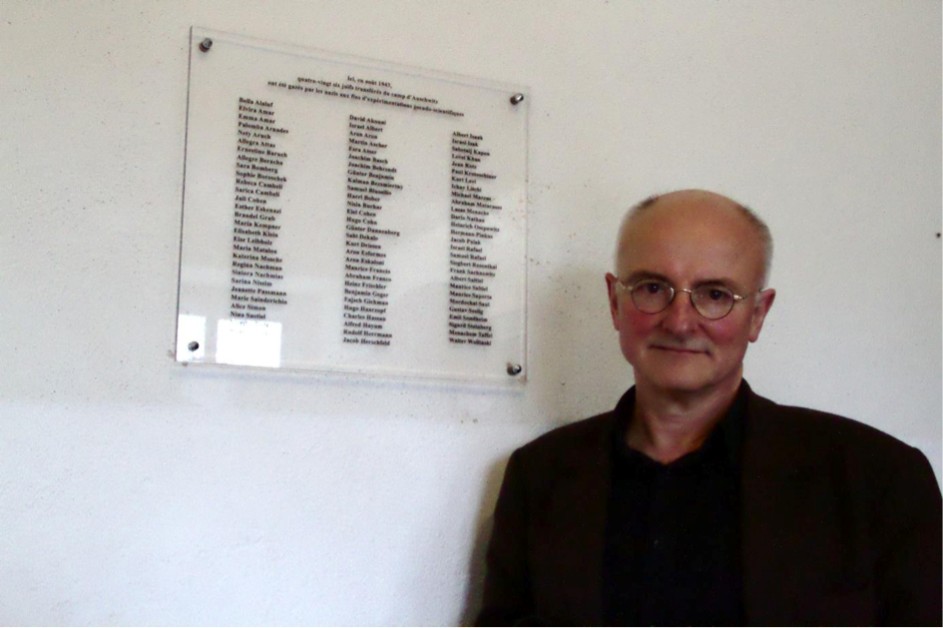
Hans-Joachim Lang next to the memorial plaque directly next to the gas chamber, Photo: Truong-Ngoc
In front of the gas chamber of the former concentration camp Natzweiler-Struthof, a memorial plaque with the names of the 86 victims is placed.
December 11th.
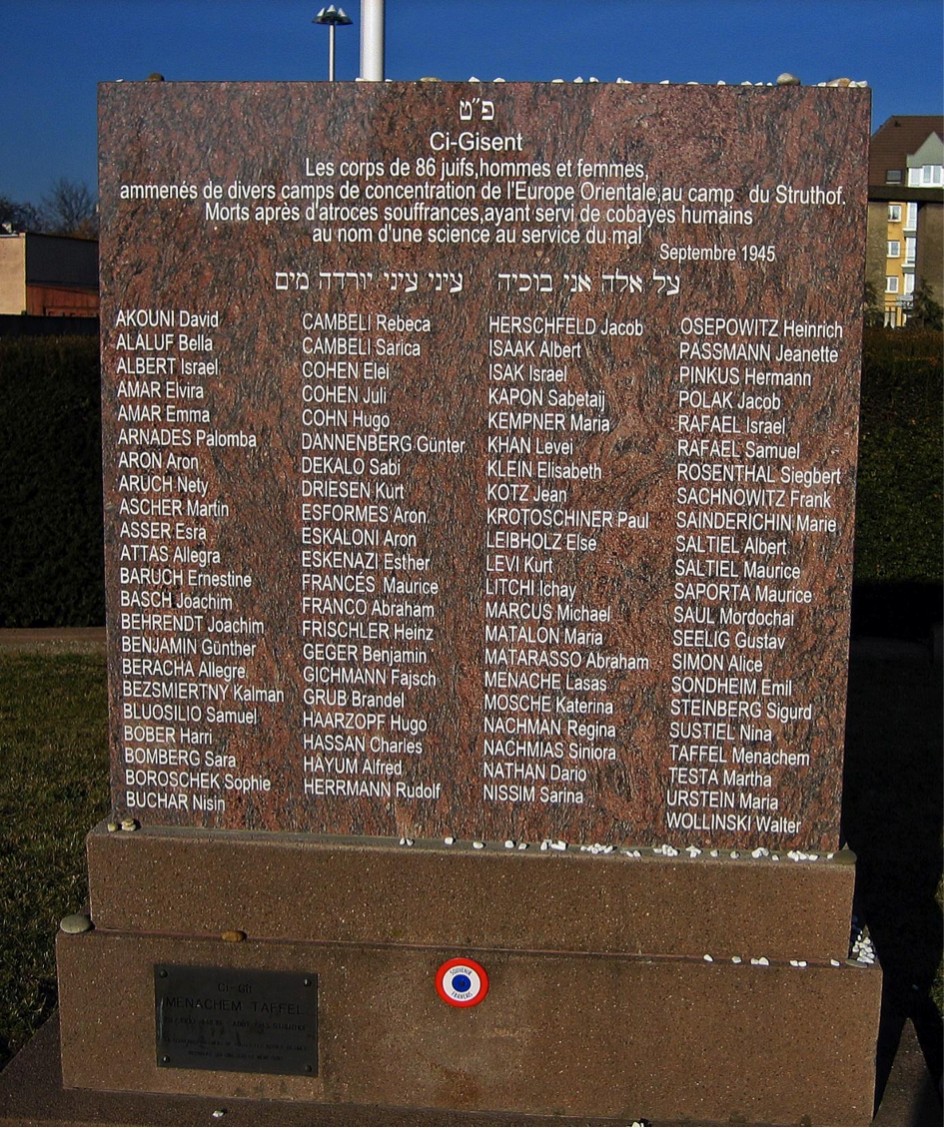
There is a mass grave at the Jewish cemetery in Strasbourg, in which the 86 “Ahnenerbe” victims are laid to rest. Until now, there stood a grave stone here, the writing on which only spoke of the crime in general. In a celebratory late-morning ceremony, a gravestone is revealed, on which all 86 names are engraved. Countless relatives from Belgium, Germany, France, Great Britain, Israel and Austria have come, from Greece also even a representative of the Jewish community of Thessaloniki. Also in attendance were the president of the umbrella organization of Jewish organizations in France, as well as leading French regional and local politicians. Beforehand, at the entrance of the Anatomical Institute of the University of Strasbourg, a memorial plaque is revealed, reminding of the crimes of Professor August Hirt and his helpers.
Reviews: Dr. Urban Wiesing counts the murders of the 86 Jewish women and men to be one of the “most horrible crimes of the national socialist doctors.” Wiesing is a professor of medical ethics at the University of Tübingen. In the Newspaper for Medical Ethics (61st volume, published March 2005), he wrote among other things, about The Names of the Numbers:
“This book is unusual. It tells one of the most horrible stories of the crimes committed by Nazi doctors. August Hirt, professor of anatomy at the University of Strasbourg, wanted to put together a collection of Jewish skeletons for scientific documentation in future “Jew-free” times. (...)
“The author is a journalist from Tübingen. Over the course of several years and after completing comprehensive research on the subject, he succeeded to give the victims back their names. The book tells of the meticulous, sometimes detective-like search for clues, of the lucky coincidences of tradition, of support, of fallbacks and difficulties, of decisive discoveries. It describes men and women, their stories, their lives with their families, with all the happiness, suffering and uncertainty. It tells of their deportation to Auschwitz, their “measurement,” their further transport to the concentration camp Natzweiler-Struthof and their murder. All of their stories share one thing in common: they end, after these human beings’ lifeless bodies travel long distances through Europe and end up in the Strasbourg Anatomical Institute, because doctors and anthropologists wanted to put together a collection of Jewish skeletons, motivated by racial mania and pseudoscientific reasons, a documentation for posterity. The book gives insight to the organizational structure and the bureaucracy of a form of medicine that believed itself authorized in its supposed scientific character to perfidious murder. It conveys upon the reader an understanding of the doctors who never doubted their actions - not even after the war.
Hans-Joachim Lang has researched thoroughly, and his judgments well-founded. But the book is more than an essay on the moral catastrophe of medicine. It tells not only of a crime, but also writes history in a special way one step further: it gives the victims back their names. The author was awarded the prize of the Brussels Auschwitz Foundation for 2003/2004.”
Imanuel Geiss, most recently professor of recent history in Bremen, wrote, in the Yearbook of Extremism and Democracy (17th volume, 2005): “(...) In a macabre puzzle endeavor, the learned Germanics expert and journalist pieced together countless components that had been strewn across the world into a single picture, that he portrays in his book. He found his material with investigative skill in a deathly scavenger hunt through archives, interviews of the victims’ surviving relatives, whom he astutely identified, even through the use of internet. The mere description of this discovery process would make the book worth reading. (...)
Step by step Lang turns the numbers back into names, sometimes with faces (photos) and knowledge of their past individual lives. (...) The book shifts the current focus from the perpetrators onto the no longer anonymous victims. After the actual presentation, in which already the lives of some victims are vividly interwoven, the book offers short biographies of all victims, in alphabetic order, as far as information about their lives is available (...). The stories of the life and death of these 86 men and women, taken as a whole, are a moving piece of European history, most of all of course for European Jewry.”
Readings and lectures in Heidelberg (Reich President Friedrich Ebert Memorial), Berlin (Frida Leider Center), Tübingen (Edith Stein Karmel), Strasbourg (University), Freiburg (Bookstore Jos Fritz).
2004
August
Premiere of The Names of the Numbers: How 86 Victims of a Nazi Crime Were Identified from the publishing house Hoffman and Campe, Hamburg.
June
The still unpublished book’s manuscript The Names of the Numbers is awarded the prize of the Brussels Auschwitz Foundation in the Brussels City Hall.
Interview with the author on December 14th in Die Tageszeitung:
(…) TAZ: What motivated you the whole time – it took a whole five years, no?
Lang: What motivated me was the question: What could life have been, for the people who were murdered there? Where did they come from? At first I thought I could quickly find the names in an archive, but there were no details about them in the records. When an Auschwitz survivor told me finally, that one would probably never be able to find them, I felt I simply had to continue.
TAZ: Why was it so important to you? Because you felt it couldn’t or shouldn’t be, that the victims remained anonymous?
Lang: That could be, yes. Given murdered six million Jews, one can somehow come to terms with anonymity, because the number is so vast in size. But in this case the number - a mere 86 - seemed so manageable, especially since I had already reasonably reconstructed the processes. As I then came across the testimony of Henry Henrypierre, who had taken note of the numbers of the victims, I couldn’t find rest anymore. These notes must be somewhere, I thought, it would be impossible for them to be thrown away! In spite of that, I never found the original, but the copy of a transcription - after two years of research. This moment was, to tell the truth, the first great epiphany. Much later on, I was totally inspired by meeting relatives of the victims for the first time. Then, I knew I had to bring it to a close.
TAZ: Does it sometimes still surprise you, that you actually did bring the project to a close?
Lang: Actually, yes. It’s almost as if one says to oneself, there could have been no other possible outcome.
TAZ: How so? Do you mean a higher power?
Lang: Because it seems that several very different things have come together. It is – even if it sounds somewhat histrionic – an act of humanity. There was a point after which I had the impression: If I don’t do it, then no one will. (…)
Click here for the full interview: http://www.taz.de/1/archiv/?dig=2004/12/18/a0349
Reviews
- Khosrow Nosratian on December 6th in Deutschlandfunk: “(...) The highly readable book illustrates the close-knit network of exchange between scholars and the Gestapo headquarters, from which the gears that put the Holocaust in motion were made. And yet the historically savvy author always succeeds, in contrast to the gruesome “Ahnenerbe” project, at the intent of his own research – to bring those murdered once again into living memory.”
- Bernd Hesslein, on October 14th in Die Zeit: “(...) the crime against the 29 women and 57 men is mentioned already in a document published in 1947, “The Dictates of Misanthropy” by Alexander Mitscherlich and Fred Mielke. They had participated in 1946 as an observer in the Doctors' Trial of the American Military Tribunal in Nuremberg, and strove as the official correspondents of the West German medical associations "to carry forward their report, without speaking out against the process.” It probably would not have been allowed of them to do so. For the author Hans-Joachim Lang, an expert on cover-ups of Nazi crimes, this reluctance is unbearable. (...) It is an arduous task, often on the verge of failure. (...) In the end, however, after five years of traveling and difficult research, the names and numbers of those murdered finally fit. The grisly puzzle is finished, the void of anonymity, as Hans-Joachim Lang calls it, has been filled. In addition the author’s work offers a deep, sharp look into the perversion of thought, that ruled the doctors under the Nazi Totenkopf.”
- Anselm Doering-Manteuffel, Professor of contemporary history, in the Schwäbisches Tagblatt: “He is deeply suspect of content-empty commemorative rituals.” What Hans-Joachim Lang wrote a few years ago in the Tagblatt about Salomon Korn is just as true about himself. Without ever lapsing into a generalizing and accusatory, merely moralizing tone, he writes constantly about the historical suffering of the Jews in Nazi Germany. (...) Lang researches thoroughly and presents detailed results. (...)
For him it’s about making sure that the victims of the Holocaust at least are granted their own honor as part of history, which was taken away from them first in 1933, before the regime drove them to emigration, suicide or mass genocide. History is concretized through names and places, he says in the introduction to his newest book The Names of the Numbers. They first become human again, however, when they are no longer connected only to crime scenes and criminals. Whoever hides the victims oneself becomes a contributor to the crime, because the annihilation is finally completed only once they have been forgotten.
Lang succeeded, throughout his years of detective work, to make the names identifiable again, to track down relatives, to inform them of the fate of the dead, and at the same time to come up with a depiction of those murdered. His research led him throughout Europe and finally to Jerusalem and Washington. He found relatives in Argentina, in many European lands, in Israel and in the U.S. (...) “The criminals should not have the last word,” he writes in the end. It is therefore necessary to remember the victims, to search for their names, to keep them in our memory, and in such a manner to find once again a piece of the German and European past. A moving book.
- Hans -Joachim Lang on August 19th in “Die Zeit:” Skeletons for Strasbourg. Extensive: http://www.zeit.de/2004/35/A-Strassburg
Readings in Brussels (Auschwitz Foundation), Tübingen (Book store Gastl), Frankfurt (Fritz Bauer Institute).
2003
September 21st
Lecture in Strasbourg at a colloquium of the Cercle Taffel on the state of the research. At the end of the lecture, the first public reading of the names of the 86 Jewish women and men, who were made victims of the “Ahnenerbe” atrocity. The audience stands for a moment in commemoration of the victims.
1999 – 2003
Visits to further archives, including the archive in Oświęcim (Archive of the memorial to Auschwitz-Birkenau) and Jerusalem (Archive of the memorial to Yad Vashem), countless correspondences with local archives and authorities in Belgium, Germany, France, Greece, the Netherlands, Austria and Poland as well as the beginning of correspondence and meetings with familial relatives of the 86 “Ahnenerbe” victims.
1999
After a long search, the first important step in the search for the identities of the 86 “Ahnenerbe” victims is made on March 4th: the discovery of a copy of the sought-after document, on which the 86 numbers were jotted down, in the United States Holocaust Museum in Washington, D.C. It is a transcript made by the French military police of the list, which Henry Henripierre had saved for the time after the liberation of Strasbourg. This number list allowed Lang to find, thanks to documents from the concentration camp Auschwitz, the places from which these 86 women and men were deported to Auschwitz: Oslo (N), Oranczyce (PL), Berlin (D), Thessaloniki (GR), Trier (D), Drancy (F), Mechelen (B), Westerbork (NL). During the next stage of the search, with the help of a document from the Auschwitz-Birkenau concentration camp, the numbers would be turned into names. But still no biographies.
1998
Beginning of the intensified search for the names of the 86 “Ahnenerbe” victims. The first reference point is a letter, written by “Ahnenerbe” leader Wolfram Sievers on June 21st, 1943 to Adolf Eichmann. Under the subject “Building a collection of skeletons,” he shared that the anthropological work was finished and that the prisoners in question were divided up between men and women, and each group was housed in a hospital building in Auschwitz. Further, it is written: “A registry of the names of selected persons is attached.”
The search for this list, in a variety of places including the National Archives in Washington, D.C., was unsuccessful. According to notation on the text, the letter had been issued five times. The version submitted in the Nuremberg Doctors’ Trial, now accessible through the research, is a carbon copy message to Rudolf Brandt (the personal assistant of SS leader Heinrich Himmler) without any attachment. The transmission from Eichmann's department in the Reich Security Main Office is completely absent.
From now on the further search concentrated upon a statement from Henry Henripierre to the court at the Nuremberg Doctors’ Trial. Henripierre, a co-worker of August Hirt at the Anatomical Institute of the Reich University Strasbourg, had received the 86 corpses from the concentration camp Natzweiler Struthof in August 1943. The strange numbers tattooed on their underarms caught his attention, so he wrote them down not only in the corpse book of the institute, but also secretly on a piece of paper that he hid in the apartment of his romantic partner.
French archival law now began to make some problems for the research. An application filed with the French Ministry of Defense for the shortening of the waiting period for documents of military justice was rejected - in spite of recommendations from the German Minister of Justice Herta Däubler-Gmelin and the French Holocaust researcher Serge Klarsfeld, whom I specially visited in Paris.
1996 – 1998
The offenders’ side of the research project about the “Ahnenerbe” murders of the 86 Jews is temporarily closed. In addition, there appears two essays: one in the weekend edition of the Frankfurter Allgemeinen Zeitung of March 21st, 1998 (“Not everything went according to the plan. The SS anatomist August Hirt: his murderous works, his disappearance and his whereabouts.”) and another in the regional history newspaper Land zwischen Hochrhein und Südschwarzwald (Title: “Grave Nr. 27, Grafenhausen, August Hirt. On the crimes and the last years of life of a professor of anatomy, sought after worldwide.”)
1994 – 1995
Research in the national archives in Bern and Berlin, as well as in the Hauptstaatsarchiv Wiesbaden, in the Generallandesarchiv Karlsruhe and in the Nuremberg State Archive. A feature during the interim as a special page in the Schwäbisches Tagblatt on July 8th, 1995: “The whole world searched for the professor of anatomy. How SS Doctor August Hirt eluded responsibility.” Exchange of letters with Renate Hirt, the daughter of the anatomy professor. Correspondence with Hermann Langbein, at that time the secretary of the “Comité International des Camps,” about research problems. On January 14th, 1995, Hermann Langbein was the first to whom I shared my resolution to “clear up the fate of these 86 people as far as I could as part of my research.”
1993
Attempts made in vain, in national daily newspapers, to gather contributions for the anniversary: in August it had been 50 years since the 86 Jewish women and men were murdered. The time was already too heavy at the appropriate date; the memory of evil was already too strong. According to the editor of the category: “Twice, in quick succession, Nazi crimes… that would scare away the readers. Like every medicine, one can administer the always - or now more than every - necessary educational pieces only in small doses.”
1992
Research in the Swiss National Archives in Bern and in the German National Archives in Berlin, the State Archive in Ludwigsburg and in August Hirt’s last place of residence, Schönenbach in the Black Forest. None of the then-accessible monographs allowed for any clarification of the circumstances and the location of August Hirt’s death, and also nothing about where a grave might be found. The goal of the research was to find clarity here.
1984/1985
The prolonged discussion of the Tübingen anthropologist Sophie Ehrhardt led to my own research and discoveries about the history of the subject. It was through this research that I became aware of the anatomy professor August Hirt. Hirt had fled from Alsace shortly before the liberation in 1944 and found a place of residence in Tübingen, where the Reich University Strasbourg had also been relocated. From the archival processing of this thread, my first essay sprang into being as a beginning life theme: “SS scientists murdered 86 concentration camp prisoners: for the construction of a skeleton collection. Dark cross connections to the ‘Tübingen anatomy warehouse.’” Special page in the Schwäbisches Tagblatt on December 21st, 1985.
1981
September 23rd.
Participation as a journalist at the 17th Meeting of the German Society for Anthropology and Human Genetics in Göttingen. There, scientists who came from both Germany and abroad were confronted with the national socialist heritage of anthropology. Requests were made to exclude the Tübingen anthropologist professor Sophie Ehrhardt from the society. Ehrhardt had been active in various positions as a researcher of race at the time of National Socialism, including from 1939 to 1942 as scientific co-worker of the Racial Hygiene and Population Biological Research Center of the Reich Health Office in Berlin. That she did research in 1980 with old files of this agency, which she had partly created by herself, in the Tübingen University Archives, prompted a group of Sinti to a spectacular sit-in. Their request, to give the concerned acts to the national archive in Koblenz right away, succeeded. The action caused great discussion about the fate of German Sinti and Roma, and the research thereof. An even more intensive discussion of this theme followed the first special page about the history and present situation of anthropology in October 1981 in the Schwäbisches Tagblatt.
September 2nd - 9th.
Upon the first official invitation through the city of Tübingen, Jewish emigrants arrived in their old home town. On the program for the week-long visit stood a reception in the city with the literary critic (and returned emigrant) Hans Mayer as well as discussion events and excursions into the immediate vicinity. As a journalist, I had many opportunities to come into conversation with the ex-Tübingers from Great Britain, Israel, Portugal, South Africa, and the USA. The emotionally moving and intellectually stimulating encounters provided me with the impetus to want to learn not only the history of the city of Tübingen during the times of National Socialism, but also that of the victims during the same time.



